Introduction
Within This Page
Landscape architecture is the comprehensive discipline of land analysis, planning, design, management, preservation, and rehabilitation. The profession of landscape architecture has been built on the principles of dedication to the public safety, health and welfare; and recognition and protection of the land and its resources.
Currently 47 states require landscape architects to be licensed or registered. Although requirements vary from state to state, licensure is based upon the Landscape Architecture Registration Examination (L.A.R.E.), which is sponsored by the Council of Landscape Architectural Registration Boards.
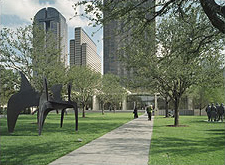
2004 ASLA Award Recipient, Nasher Sculpture Center, Dallas TX, by Peter Walker and Partners. Photo Credit: Tim Hurley's Studio—Tim Hurley
The national professional association representing landscape architects is The American Society of Landscape Architects (ASLA), which was founded in 1899. Beginning with 11 original members, ASLA has grown to more than 15,000 members and 48 chapters, representing all 50 states, U.S. territories, and 42 countries around the world. ASLA promotes the landscape architecture profession and advances the practice through advocacy, education, communication and fellowship.
- The American Society of Landscape Architects
- ASLA Public Policies
- Australian Institute of Landscape Architects
- Award Winning Landscape Design, Analysis, and Planning
- Canadian Society of Landscape Architects
- Federation of German Landscape Architects
- International Federation of Landscape Architects
- Landscape Architecture Body of Knowledge Study Report
- The Landscape Institute—United Kingdom
- U.S. Bureau of Labor Statistics Occupational Outlook Handbook—Landscape Architects
Description
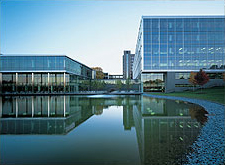
2004 ASLA Award Recipient, General Mills Corporate Headquarters, Minneapolis, MN, by oslund.and.assoc Photo Credit: George Heinrich
Landscape architecture can be traced to the origins of man and early agricultural development, although it did not evolve into a profession until the mid-19th Century, as society sought to meet many of the new challenges of industrialization and urban growth. With that concern came the realization that cities, in particular, had to be more functional, welcoming, and aesthetically pleasing to their inhabitants. Frederick Law Olmsted (1822-1903), best known for his design of Central Park in New York City, was an early proponent of the more formalized consideration of man's interaction with the land, and has long been acknowledged as the founder of American landscape architecture.
Today, projects that involve the work of landscape architects include: residential, parks and recreation, monuments, urban design, streetscapes and public spaces, transportation corridors and facilities, waterway restoration and reuse, gardens and arboreta, security design, hospitality and resorts, institutional, academic campuses, therapeutic gardens, historic preservation and restoration, conservation, corporate and commercial, landscape art and earth sculpture, interior landscapes, and more.
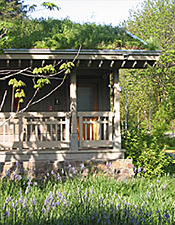
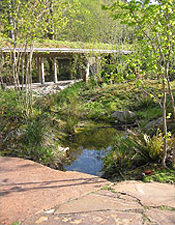
2004 ASLA Award Recipient, Cedar River Watershed Education Center, Cedar Falls, WA by Jones and Jones Architects and Landscape Architects Ltd. Photo Credit: Nancy Rottle
The inclusion of landscape architecture can have a profound impact on the "whole building design" process. Optimally, a building is not an invasion of the landscape but a vital extension of it. It is inescapable that a building must rest in a space, and that before it can be entered, it must be approached. Where a building rests on the land, and how it rests on the land, sets the context for its evolving construction, development, and use. This initial phase of the 'whole building design' process is the domain of the landscape architect. So too are the end phases of construction, when measures are taken to complete the areas around a building—the look and feel of the surfaces, hardscaped and landscaped spaces, structure itself, and the approaches to the site on which located. A well designed property, when developed within 'whole building' design principles, is properly integrated with its' surroundings; must be a good neighbor within the community where it rests to other structures and its natural setting; and should be accessible, secure, and aesthetically pleasing from the outside.
A landscape architect is the arbiter of a building's interaction with its physical location. As a part of a "whole building", collaborative approach, a landscape architect can help to answer these questions:
- Where in a community should a building be placed?
- Where does it best fit on a particular site? How can a building's interaction with the land be maximized?
- How can a building's environmental impact be efficiently managed?
- How can the goals of the owners and users be accommodated?
Because of the wide range of work that encompasses the profession, landscape architects have a great appreciation for a multidisciplinary approach to design challenges. The premium landscape architecture places on the relationship between society and the natural world also means that its' practitioners often urge the employment of sustainable design practices that balance stewardship of land—which minimizes environmental degradation and consumption—with the need to provide a healthy, productive, and meaningful life for all members of society, so that the needs of future generations are not compromised.
Good practice of landscape architecture maintains that sustainability should be an integral part of the design process. The goals associated with creating a sustainable built environment include: avoiding or otherwise minimizing the impacts on resources; conserving ecosystems; using renewable resources; avoiding waste where possible by reuse, recycling, and recovery; supporting the general realization of human potential and happiness; and creating healthy built environments and landscapes for present and future generations.
Sustainable landscape architecture accounts for the following principles:
- Ecological: the natural forces that shape a landscape, including climate, geology, hydrology, soils, elevation/landform, vegetation, wildlife, and other living organisms
- Social/Cultural: the human forces that shape a landscape including history, communities and customs, development patterns, agriculture, and social behavior and uses
- Economic: the budget realities and cost-saving considerations that shape the built environment and the fiscal requirements necessary to support livable places and communities.
Landscape architects frequently work to:
- Both enhance the understanding and strengthen the integral relationship between natural processes and human activity, and how sustainable design fits into everyday life.
- Improve practices, processes, procedures, products, and services that take into account long-tem sustainable considerations and stewardship.
- Examine policies, regulations, and standards in industry and government to identify barriers to the implementation of the principles of sustainable design.
- Encourage community and business leaders to bring the existing built environment up to sustainable design standards and to reflect the philosophy of sustainability in the design and management of their communities.
Sustainability and Building Green Links
- Biodiversity by Design: A Guide for Sustainable Communities
- Building and Fire Research Laboratory
- Building for Environmental and Economic Stability (BEES)
- Center for Maximum Potential Building Systems
- EPA Environmentally Preferable Purchasing
- GardenMart
- GardenWeb
- Green Landscape Architects
- Green Roofs for Healthy Cities
- Green Space Design
- Irrigation and Green Industry Network
- Low Impact Development Center
- Low Impact Development Urban Design Tools
- U.S. Green Building Council
Emerging Issues
Security Design
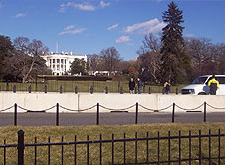
View of White House from the Ellipse
In recent years the security of public places and federal sites has become an increasingly urgent concern. The federal government has moved swiftly to install a full range of security responses to thwart terrorism. Physical barriers, surveillance, and metal detection devices and protocols have either been strengthened or established. By their nature, these measures channel and restrict personal movement. The challenge has become to protect citizens without erecting barriers that have a detrimental impact to how people interact with the government and with each other.
The principles for combining security and good landscape design include:
- Provide an adequate balance between threats and the beauty of the public realm.
- Recognize that good design and good security are not incompatible.
- Expand the palette of elements that can gracefully provide perimeter security, producing a coherent security and urban design strategy that embraces whole streets and districts.
- Provide perimeter security without dampening the pedestrian activity and the vitality of public streets.
Landscape architects are uniquely qualified to develop and showcase design principles that achieve an appropriate balance between security measures and an open society that values its democratic principles, freedom of movement, and accessible public spaces.
Security Design Links
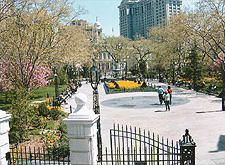
City Hall Park, New York City Photo Credit: ASLA
- Designing For Security in the Nation's Capital
- FEMA Hazard Mitigation Publications
- The National Capital Urban Design and Security Plan
- PBS-P100 Facilities Standards for the Public Buildings Service (GSA)
- Safe Spaces: Designing For Security and Civic Values
- UFC 4-010-01 DoD Minimum Anti-Terrorism Standards For Buildings
Designing Healthy Communities
Every national assessment of healthier living has identified the importance of exercise and recreational opportunities—yet it has become clear that Americans are not active enough, in part because we have increasingly designed daily physical activity out of our lives. Site planning must encourage creating or improving access to places for physical activity.
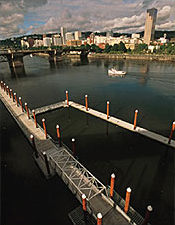
2004 ASLA Award Recipient, Eastbank Esplande, Portland, OR, by Mayer/Reed Photo Credit: Bruce Forster Photography
Landscape architects work with developers, homeowners, and public officials to:
- Transform existing facilities such as streets, parks, plazas, and public open spaces into safe, attractive, functional amenities for the benefit of the community.
- Enhance and complement other park and recreation programs, leading to a more integrated community wide system.
- Encourage communities to promote buildings that are mixed with other land uses affording individuals the ability to live, learn, work, shop, and play in a healthy, walkable setting.
- Protect and enhance natural, cultural, and scenic resources and avoid environmental land degradation by respecting ecological systems and landscape character.
- Design facilities that are well connected to communities by sidewalks, bike trails, and transit service, as well as roadways.
- Ensure that individuals of all levels of mobility have full access to transportation networks.
Active Living, ADA, and General Health Links
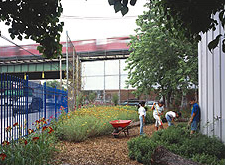
Community4—2004 ASLA Award Recipient, Learning Garden for P.S. 19, Queens, NY, by Ken Smith Landscape Architect Photo Credit: Paul Warchol Photography
- Active Living by Design
- Active Living Research
- ADA Accessibility Guidelines (ADAAG)
- American Horticultural Therapy Association
- Americans with Disabilities Act Information
- Therapeutic Landscapes Network
- U.S. Access Board: Accessibility for People with Disabilities
Transportation and Smart Growth Links
- American Public Transportation Association
- National Center for Sustainable Transportation (UC Davis)
- National Complete Streets Coalition
- Partners for Livable Communities
- The Pedestrian and Bicycle Information Center
- Planetizen—The Planning and Development Network
- Research Design Connections
- Smart Growth Network
- Walkable Communities, Inc.
Water Resource Planning and Management
Water is a finite and valuable resource that is widely shared for human activities and natural processes. Over time, water quality in the United States has been greatly reduced due to numerous factors, but through proper planning and management of waterways, wetlands, aquifers, and coastal zones this trend can be reversed. The nation depends on ample, clean water supplies to sustain a high standard of living and maintain the quality of ecosystems.
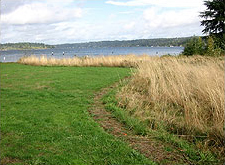
2004 ASLA Award Recipient, Trillium Projects, Seattle, WA, by Charles Anderson Landscape Architecture Photo Credit: Charles Anderson Landscape Architecture
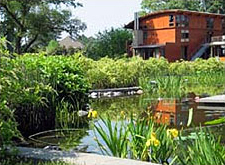
2004 ASLA Award Recipient, Tidewater Residence, Tidewater, VA, by Nelson Byrd Woltz Landscape Architects Photo Credit: Nelson Byrd Woltz Landscape Architects
Landscape architects have designed numerous innovative approaches to provide for the efficient use of water and the protection of water quality. This includes the design, planning, and management of coastal zones, waterways, enhancement and revitalization of wetlands, wastewater treatment, storm water management, and irrigation.
Currently, our nation's water quality is not optimal: waterways have become dumping grounds for wastes; fossil water reserves are drawn down; wetlands are being drained and filled; rivers are channelized; building over streams and in floodplains has increased downstream flooding; obsolete infrastructure has generated "non-point" pollution, such as storm water runoff from general urban or agricultural areas, that cannot be traced to a specific source.
Storm Water
Impervious surfaces caused by sprawling urban development increase volumes and rates of storm flows, which carry pollutants into streams, prevent groundwater recharge, and reduce stream base flows. Often the channels, dams, and reservoirs built to mitigate these effects have further disrupted ecosystems and human communities. To begin to address this problem, runoff and effluents can be reclaimed to reduce the need for imported fresh water; reservoirs of all kinds can be adapted to integrate with multi-functional natural ecosystems and human communities; and new development can be arranged and constructed to minimize impervious surfaces. In addition, excess storm water runoff can be directed through soil and vegetation to recharge ground water.
Coastal Zones
Fresh water and salt water coastal zones may be described as those areas along the land/water interface affected by waves and currents, storms and spray, and characterized by a variety of landforms, including coral reefs, rocky headlands, sandy beaches, sand dunes, vegetated sand flats, maritime forests, inlets, bays and estuaries. Landscape architects work on management and development strategies that reflect and acknowledge that many of the landforms within the coastal zone, such as barrier islands, undergo constant natural change, and are not stable or fixed in a place.
Waterways
Waterways should be managed from a multi-use approach, including scenic and cultural values, wildlife resources, and recreational potential, as well as appropriate commercial development potential. Planning for an entire watershed, designation of appropriate land uses near waterways, and implementation of riparian buffer to protect stream-bank erosion and filter adjacent agricultural runoff is necessary to protect water resources.
Wetlands
With an understanding that the development pressures on wetlands continue to increase, landscape architects work toward site-specific development and management efforts that allow for compatible land uses while preserving the ongoing function of wetland resources.
Water Resource Planning and Management Links
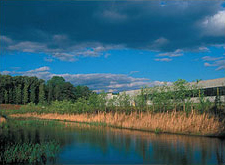
2005 ASLA Award Recipient, 12,000 Factory Workers Meet Ecology in the Parking Lot, by Michael Van Valkenburgh Associates, Inc. Photo Credit: Ron Anton Rocz
- American Association of Port Authorities
- American Water Works Association
- ASCE Journal of Water Resources Planning and Management
- ASCE Report Card for America's Infrastructure
- Coastal Conservation Association
- EPA Office of Wetlands, Oceans and Watersheds
- Inland Waterways International
- National Park Service Water Planning
- National Waterways Conference
- NOAA Coasts Page
- Tulane University Coastal Zone Primer
- U.S. Army Corps of Engineers Civil Works
- U.S. Fish and Wildlife Service - National Wetlands Inventory
- U.S.G.S. National Wetlands Research Center
- Wetlands International
- Wetlands Studies and Solutions
Landscape Preservation
During the past two decades the definition of historic preservation has gone beyond the singular historic building or urban district to include the historic landscape that provides the setting and context for a property. Historic landscapes are special places. They are important representations of national, regional, and local identity and culture. They foster a sense of community and place. Historic landscapes are also fragile places, affected by the forces of nature, by commercial and residential development, and by vandalism and neglect.
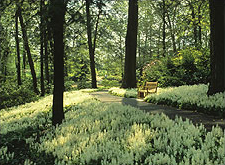
2004 ASLA Award Recipient, Peirce's Woods at Longwood Gardens, Kennett Square, PA by W. Gary Smith, ASLA Photo Credit: W. Gary Smith, ASLA
Landscape preservation also encompasses the stewardship of public lands, rural landscapes, forests, and parks by careful assessment to determine uses that are consistent with long-term sustainability. Appropriate land use decisions sustain natural systems, utilize the best management practices for the development of extractive resources, and where possible, consolidate private lands with public lands to better protect habitats and increase aesthetic and recreational opportunities.
The consideration of vegetation and wildlife habitats, both major influences on health and quality of life in the built environment, are also and important component of landscape preservation efforts. Trees, shrubs, grasses, and herbaceous plant material filter pollutants in the air and water, mitigate wind and solar heat gain, stabilize soil to prevent or reduce erosion, and provide an aesthetic counterpoint to the built environment. These attributes are essential to balancing human effects of the land, and provide some of the strongest cues to the unique identity of a place.
Historic Preservation
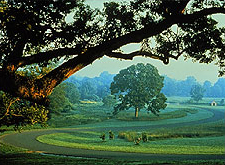
2004 ASLA Award Recipient, Morris Arboretum, University of Pennsylvania Photo Credit: Nick Kelsh
- Advisory Council on Historic Preservation
- Bureau of Land Management National Conservation Lands
- Historic American Buildings Survey
- Historic American Engineering Record
- Historic American Landscapes Survey
- National Association of Tribal Historic Preservation Officers
- National Conference of State Historic Preservation Officers
- National Park Service—National Register of Historic Places Program: Landscape Initiative
- National Preservation Institute
- National Trust for Historic Preservation
- The Trust for Public Land
Horticulture
Relevant Codes and Standards
Accredited Programs for the Study of Landscape Architecture
- ASLA Code of Environmental Ethics
- ASLA Code of Professional Ethics
- Council of Landscape Architectural Registration Boards (C.L.A.R.B.)
- Landscape Architecture Accreditation Board (LAAB)
- Landscape Architecture—Professional Practice
- Landscape Architecture State Licensure Requirements
Additional Resources
Related Organizations
- The American Public Gardens Association
- The American Institute of Architects
- American Planning Association
- American Society of Golf Course Architects
- Association of Professional Landscape Designers
- The Brick Industry Association
- The Construction Specifications Institute
- Council of Landscape Architectural Registration Boards
- The Design Build Institute of America
- Interlocking Concrete Pavement Institute
- International Society of Arboriculture
- The Irrigation Association
- National Association of Landscape Professionals
- National Concrete Masonry Association
- National Council for Science and the Environment
- National Recreation and Park Association
- The New York Botanical Garden, The Catalog of Landscape Records
- Pace University Land Use Law Center
- Society of Municipal Arborists
- Tree Care Industry Association
- Urban Land Institute
- The Urban Parks Institute
Software Resources
- Autodesk—AutoCAD
- CADdetails
- Eagle Point—LANDCADD
- Environmental Systems Research Institute (ERSI): GIS and Mapping Software
- ERSI Virtual Campus
Professional Journals
- Architectural Record
- Architect Magazine
- Building Green
- Ecotecture, The Online Journal of Ecological Design
- Environmental Design + Construction
- Garden Design
- Green At Work
- Horticulture
- Landscape Architecture Magazine
- Landscape Architecture Australia
- Landscape Management
- Native Plants Journal
- New Urban Network
- Terrain.org
- Topos








